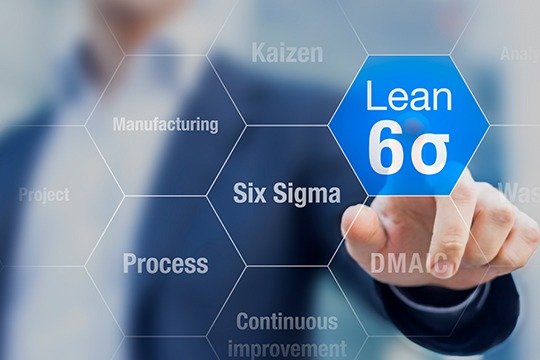Six Sigma Green Belt Certification is for the professionals who want to decrease the defects in the processes they are creating. Techniques taught in this certification will help you in making the projects defect free. Six Sigma Green Belt is the stepping stone to the detailed and systematic approach to find and eliminate defect from products/services. Six Sigma Green Belt Certification will provide you a deeper understanding of the Six Sigma tools and techniques.
Course Objective
Upon completion of the Six Sigma Green Belt course, participants will learn how to:
- Identify project selection and evaluation criteria.
- Plan and execute six sigma projects.
- Form and effectively lead a six sigma project team.
- Apply DMAIC (Define, Measure, Analyze, Improve, and Control) and various six sigma tools in process and quality improvement.
- Assess and manage project risk.
- Significantly increase profitability through six sigma projects.
- Avoid pitfalls in implementing six sigma.
- Integrate and enhance innovation and problem solving skills.
Course Outcome
- This course aims to familiarize Participants with the tool and techniques, advantages, and challenges of the Six Sigma methodology.
- Participants will be equipped with the knowledge needed for production process improvement in their organizations and help their organizations adopt Six Sigma methodology.
- Participants have knowledge pertaining to and can anticipate issues related to the practical implementation of Six Sigma.
- Participants are armed with the proper tools to address, resolve, and take the lead on production issues in their organizations.
- Participants will develop superior problem solving skills that can be immediately applied in real world projects.
Who should do this course
- This course is for employees and organizations requiring a standardized approach to problem solving for the purpose of continuous improvement. This would include team leaders, supervisors, associates, Quality Assurance Engineers, Project Managers, Software Professionals, Practitioners, Quality Assurance team members, Working Executives and Senior Management that will dedicate a small portion of their time applying the DMAIC tools to their natural work area.
- Management and Engineering Students who are desirous to be more resourceful and employable.
-
Introduction to Six Sigma
1Scrum Overview2Scrum Principles3Scrum Aspects4Scrum ProcessesStakeholders & Setting up a Six Sigma Project
1Core Role: Product Owner2Core Role: Scrum Master3Core Role: Scrum Team4Non-core Roles5Project Selection Criteria6Identifying performance metrics7Using Financial criteria to evaluate project benefits8Maximizing project benefits for the organization9Project Planning10Creating Project Charter11Charter Negotiation12Managing Team Dynamics13Initiating t14Stages of team evolution15Maslow’s hierarchy of needs16Motivation Techniques17Conflict Resolution Techniques18Management / Leadership styles19Roles played by people in a project20Important project management & planning toolsSix Sigma Methodology – Define
1Responsibilities of Scrum Roles in Business Justification2Factors used to Determine Business Justification3Business Justification Evaluation Techniques4Tools for Planning Value5Continuous Value Justification6Summary of Responsibilities7VOC8Kano’s Customer Satisactin Levels9Juran’s Custmer Needs10CTQ Flowdown11QFSix Sigma Methodology – Measure
1Quality Defined2Acceptance Criteria and the Prioritized Product Backlog3Quality Management in Scrum4Quality Planning5Continuous Integration and Sustainable Pace6Quality Control and Quality Assurance7Fishbone Diagram8Summary of Responsibilities9Basic Statistics10Analytical Statistic11Gauge12Process Capability Analysis13Baseline proces capability14Process parameters affcting CTQs15Cost of poor quality (COPQ)16MeasuremntSix Sigma Methodology – Analyze
1Unapproved and Approved Change Requests2Change in Scrum3Balancing Flexibility and Stability4Achieving Flexibility5Changes to a Sprint6Impact of Expected Change on the Length of Sprint7Managing Changes through Prioritized Product Backlog Grooming8Managing Changes During Demonstrate and Validate Sprint9Cost of poor Quality (COPQ)Six Sigma Methodology – Improve
1What is Risk?2Risks and Issues3Risk Management Procedure4Risk Identification5Risk Assessment6Risk Assessment Techniques:7Risk Mitigation8Risk Communication9Risk analysis10Minimizing Risks through Scrum11Summary of Responsibilities12Implementation planSix Sigma Methodology – Control
1Statistical Process Control2Other Control Tools3Maintain Controls4Sustaining Improvements5Lean enterprise65S7Kaizen8Kanbn9Total productive maintenance10Measurement system reanalys11Implemented solutions12Reviswdd measurement system13Control plan for sustaining benefits14Improves procedss capability15Lessons ledarnedCase Study
1Case Study Part 12Case Study Part 23Case Study Part 3Multiple Choice 90 questions per exam One mark awarded for every right answer No negative marks for wrong answers 120 minutes duration Proctored online examAll leading companies in the world use Six Sigma. Six Sigma has come a long way since its inception in the mid 80’s. In the present day, Six Sigma is one of the most widely applied methodologies for improvement projects globally. Also, the widespread increase in the demand for certified Six Sigma professionals is a testimony to the fact that Six Sigma is here to stay.Initially GE and Motorola developed certification programs (belt) to verify individuals’ expertise on the Six Sigma methods at the relevant skill level — entry level to expert. After that many organizations in the 1990s started offering Six Sigma certifications to their employees. 6sigmastudy have been offering Six Sigma certifications and trainings for more than one decade and is one of the reputed names in this field. Various Six Sigma certifications offered by 6sigmastudy are : Six Sigma Yellow Belt Six Sigma Green Belt Lean Six Sigma Green Belt Six Sigma Black Belt Lean Six Sigma Black Belt easyScholars is Authorized Training Partner of 6sigmastudyYes, Six Sigma Study is one of the certification body for Six Sigma Certifications. Six Sigma courses have various certification bodies which provide this certification. Six Sigma Study is one of those certification bodies.Yes. easysScholars is an accredited training partner (ATP) which is accredited to Six Sigma Study to provide these training and certification.Once you complete your preparation the candidate can schedule the exam in the online portal of the course access provided. The certificate will be issued within one hour of completing the exam.



Reviews
There are no reviews yet.